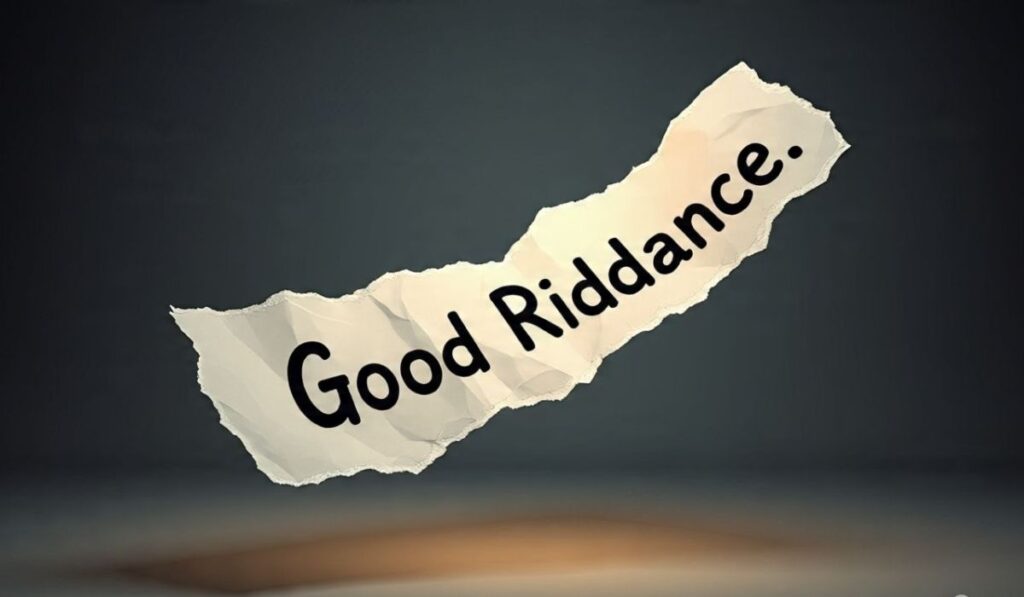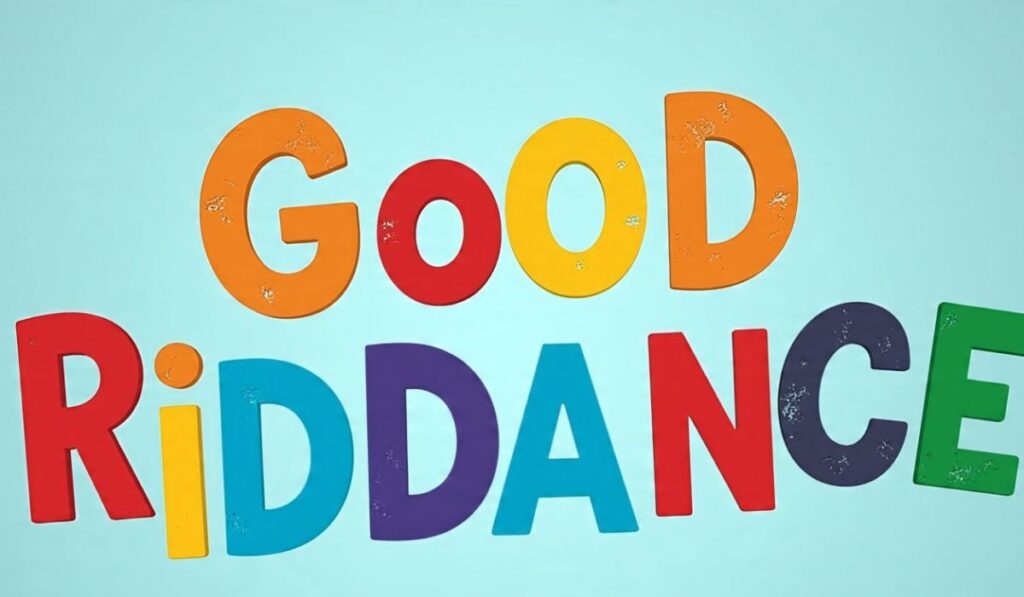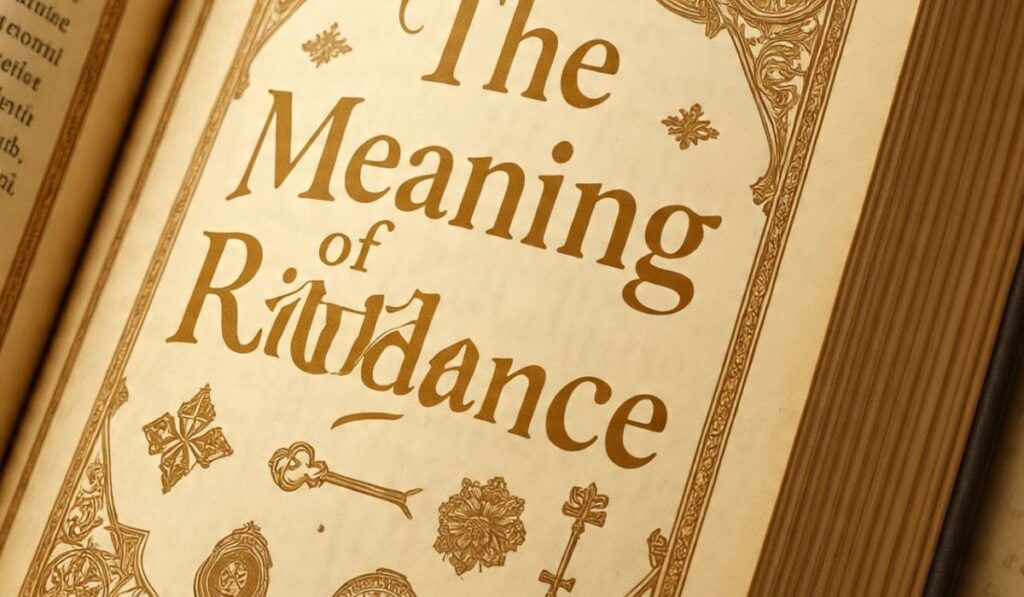“Good riddance” is a phrase that has stood the test of time, evolving from its historical roots into a widely recognized expression of relief or dismissal. In 2025, its usage spans everything from casual conversations to viral social media moments, often signaling the end of an unwelcome presence or experience.
Whether used sincerely or with biting sarcasm, “good riddance” carries cultural weight, reflecting changing social attitudes and the modern tendency to speak more bluntly.
Understanding its history, current applications, and influence in pop culture offers deeper insight into how language adapts to human emotion and shifting societal norms.
Understanding “Good Riddance”
“Good riddance” is an English expression used to convey relief or satisfaction at the departure of someone or something unwelcome. Often delivered with a tone of finality, it reflects a sense of closure or emotional release. The phrase typically implies that whatever—or whoever—is leaving was more of a burden than a benefit.
While it can be used in casual, serious, or even humorous contexts, its underlying meaning remains consistent: it’s better that the subject is gone. Whether spoken in frustration, sarcasm, or honest relief, “good riddance” captures a powerful emotional reaction to letting go.
Literal Definition
“Good riddance” literally means that it is good to be rid of someone or something. It combines the word “riddance,” meaning the act of getting rid of, with the word “good” to express that the removal is welcome or beneficial.
- Derived from Middle English term “ridden,” meaning to clear or remove.
- Implies that what is gone was unwanted or problematic.
- Often used with a tone of relief or satisfaction.
- Closely related in meaning to “finally gone” or “thank goodness it’s over.”
- Emphasizes the positive aspect of something ending or leaving.
Common Contexts
“Good riddance” literally means that it is good to be rid of someone or something. It combines the word “riddance,” meaning the act of getting rid of, with the word “good” to express that the removal is welcome or beneficial.
- Derived from Middle English term “ridden,” meaning to clear or remove.
- Implies that what is gone was unwanted or problematic.
- Often used with a tone of relief or satisfaction.
- Closely related in meaning to “finally gone” or “thank goodness it’s over.”
- Emphasizes the positive aspect of something ending or leaving.
Tone & Emotion
“Good riddance” appears in a variety of situations, from personal relationships to cultural commentary, and is used whenever someone wants to highlight the benefit of something being gone.
- Used when ending toxic relationships or friendships.
- Expressed after quitting or losing a stressful job.
- Common in politics or media when public figures exit controversially.
- Shared online in memes or reactions to negative events ending.
- Used in music, movies, and literature to convey emotional closure.
Origin of the Phrase “Good Riddance”

The phrase “good riddance” dates back to the late 16th century and is rooted in early Modern English. The word “riddance” originally meant the act of clearing away or removal, and pairing it with “good” emphasized that the departure was welcomed.
One of the earliest known uses appeared in Shakespeare’s Troilus and Cressida (1606), showcasing its long-standing role in English literature. Over time, the phrase evolved from formal usage to a more casual, even emotionally charged expression.
Today, “good riddance” remains a popular way to signal relief, finality, or emotional closure when something or someone unwanted is gone.
Historical Background
The expression “good riddance” has its roots in Elizabethan English and was commonly used during the 16th and 17th centuries. It gained popularity as a pointed way to express approval of someone or something being gone.
Over time, it transitioned from formal language into a widely used idiom that conveys emotional relief or disdain. Its tone and context have evolved, but its core meaning has remained remarkably consistent through the centuries.
- Originated in the late 1500s in English literature.
- Used to emphasize satisfaction at someone’s exit.
- Common in both everyday speech and dramatic works.
- Retained popularity across various English-speaking regions.
- Showcases the shift from formal to idiomatic English.
Etymology of “Riddance”
The word “riddance” comes from the Middle English verb ridden, meaning to clear, remove, or rescue. It was used in older English to describe the act of getting rid of something, often in a literal sense, before taking on more emotional or metaphorical meanings.
- Derived from the Middle English “ridden.”
- Originally meant “the act of clearing away.”
- Later took on emotional connotations, like relief or disgust.
- “Riddance” fell out of solo use but lives on in the phrase.
- Its evolution reflects the fluid nature of English vocabulary.
Famous Early Examples
One of the earliest and most famous uses of “good riddance” appears in William Shakespeare’s Troilus and Cressida (1606), giving it a literary boost that helped the phrase endure. Other early references appear in English plays and poetry, cementing its role as a dramatic and expressive idiom.
- Troilus and Cressida by Shakespeare: “Thou hast not so much charity in thee as to go to the ale with a Christian: thou wilt not go, good riddance!”
- Used frequently in Elizabethan and Jacobean plays.
- Appeared in courtly dialogue and dramatic dismissals.
- Early uses carried a sharper, more formal tone.
- Helped establish the phrase’s association with contempt or relief.
How to Use “Good Riddance” in Conversation
“Good riddance” is typically used to express relief or satisfaction when someone or something unwanted leaves or ends. In conversation, it often carries a negative or dismissive tone, implying that the departure is welcome and perhaps long overdue.
You might use it when a troublesome coworker quits or a toxic relationship ends, as in, “He finally moved out? Good riddance!” While it can be said seriously, it’s also sometimes used with sarcasm or humor, depending on the context and tone of voice.
Casual vs. Formal Contexts
“Good riddance” is best suited for casual settings, where emotions like frustration or relief can be openly expressed. It’s commonly used among friends, on social media, or in informal chats. However, it’s generally not appropriate in formal contexts like business emails, professional meetings, or official speeches, as it may come across as unprofessional or overly blunt.
- Used in relaxed conversations with friends or family
- Common in personal texts and online comments
- Avoid in professional emails or business settings
- Not suitable for formal writing or public speaking
- Replace with neutral phrases like “I’m glad that’s over” in formal use
Examples of Usage
“Good riddance” is best suited for casual settings, where emotions like frustration or relief can be openly expressed.
It’s commonly used among friends, on social media, or in informal chats. However, it’s generally not appropriate in formal contexts like business emails, professional meetings, or official speeches, as it may come across as unprofessional or overly blunt.
- Used in relaxed conversations with friends or family
- Common in personal texts and online comments
- Avoid in professional emails or business settings
- Not suitable for formal writing or public speaking
- Replace with neutral phrases like “I’m glad that’s over” in formal use
Tone Considerations
When using the phrase “good riddance,” tone plays a crucial role in how it’s received. The expression typically conveys strong emotions such as annoyance, frustration, or relief, and can easily sound harsh or dismissive if not delivered carefully.
In spoken conversation, your voice, facial expression, and context help soften or intensify the impact. In writing, however, without those cues, it can come across as cold or bitter. That’s why it’s important to use it thoughtfully especially if the goal is to be humorous or lighthearted rather than hurtful.
Common Variations of “Good Riddance”

Common variations of “good riddance” often carry the same sense of relief or dismissal but come in different tones and styles. Phrases like “finally rid of that,” “glad that’s over,” or “won’t miss that” are milder alternatives that express a similar sentiment without sounding too harsh.
More sarcastic or playful versions include “don’t let the door hit you on the way out” or “bye, and don’t come back.” These variations allow speakers to adjust their tone based on the situation whether they want to be blunt, humorous, or just express quiet satisfaction.
Similar Phrases
- “Glad that’s over” – A softer way to express relief without sounding harsh.
- “Won’t miss that” – Implies something or someone wasn’t valued or appreciated.
- “Don’t let the door hit you on the way out” – Sarcastic and often used to mock someone leaving.
- “About time!” – Emphasizes impatience and relief that something finally ended.
- “No love lost” – Suggests mutual dislike and no emotional attachment to the departure
Regional Differences
While “good riddance” is widely understood in English-speaking regions, its usage and tone can vary slightly depending on cultural context. In the United States and the UK, it’s commonly used in casual speech to express relief or irritation when someone or something unwanted is gone.
In countries like Australia or Canada, the phrase is also recognized but may be used less frequently or replaced with more localized expressions.
Additionally, in some cultures, direct or harsh-sounding phrases like “good riddance” might be considered impolite, so people may opt for gentler alternatives to convey the same message.
Misconceptions & Clarifications
While “good riddance” is widely understood in English-speaking regions, its usage and tone can vary slightly depending on cultural context. In the United States and the UK, it’s commonly used in casual speech to express relief or irritation when someone or something unwanted is gone.
In countries like Australia or Canada, the phrase is also recognized but may be used less frequently or replaced with more localized expressions. Additionally, in some cultures, direct or harsh-sounding phrases like “good riddance” might be considered impolite, so people may opt for gentler alternatives to convey the same message.
Overuse
Using the phrase “good riddance” too often can make a speaker seem overly negative, dismissive, or emotionally reactive. If applied to minor annoyances or used in casual conversation repeatedly, it may lose its impact and come across as dramatic or insincere.
Overuse can also create tension in relationships, especially if others feel you’re too quick to reject people or situations. Choosing when to use it carefully helps preserve its emotional weight and avoids sounding bitter or overly sarcastic.
When Not to Use It
- In professional or workplace settings – It can seem rude or unprofessional.
- During sensitive conversations – May come off as harsh or emotionally cold.
- When the person or topic is still present – Can create tension or conflict.
- In public or formal speeches – Lacks decorum and emotional sensitivity.
- When you want to maintain a neutral or respectful tone – It may feel too dismissive.
The Line Between Sarcasm and Sincerity
The phrase “good riddance” can be tricky because its meaning often depends on how it’s said. When used sincerely, it expresses genuine relief that someone or something unpleasant is gone. However, in many cases, it’s said sarcastically to mock or emphasize annoyance, often exaggerating feelings for effect.
The difference lies in tone, body language, and context; without those cues, especially in writing, it’s easy for the listener or reader to misinterpret the intent. That’s why knowing your audience and setting is key when using this phrase.
The Phrase in Popular Culture
“Good riddance” has become a well-known expression in popular culture, often used in movies, TV shows, music, and even memes to highlight dramatic exits or express emotional closure. One of the most iconic uses is in Green Day’s 1997 song “Good Riddance (Time of Your Life),” where the phrase takes on a more reflective and bittersweet tone.
In film and television, characters might say it to deliver a punchy farewell or to underscore their frustration. Over time, its popularity in pop culture has given the phrase both sarcastic and sentimental meanings, depending on how it’s delivered.
Literature and Music

The phrase “good riddance” has left a mark on both creative and everyday language. In literature and music, it’s often used to express finality or emotional release, capturing moments of goodbye or personal transformation.
In broader language, it has shaped the way people express frustration or closure, becoming a shorthand for letting go of negativity. Its versatility ranging from harsh to humorous or even reflective makes it a powerful and memorable expression across genres and generations.
- Frequently used in classic and modern literature to mark emotional turning points.
- Appears in dramatic scenes where a character parts with someone or something unpleasant.
- Popularized by Green Day’s hit song “Good Riddance (Time of Your Life),” giving it a reflective twist.
- Used in poetry and lyrics to convey closure, regret, or relief.
- Adds emotional weight or finality to a character’s dialogue or inner thoughts.
Impact on Language
The phrase “good riddance” has had a lasting influence on the way English speakers express relief, closure, or frustration. It helped popularize a direct and emotionally charged way of saying goodbye to unwanted people or situations.
Over time, it has shaped the tone of similar expressions, blending sarcasm and sincerity in a way that’s easily understood in both speech and writing. Its enduring presence in pop culture and everyday use shows how certain idioms become embedded in language, offering a quick way to communicate complex emotions.
Final thought
In 2025, the phrase “good riddance” continues to hold its place in everyday language as a sharp, emotionally charged way to express relief at someone’s or something’s departure. With roots in centuries old English and enduring popularity through literature, music, and pop culture, its meaning has evolved while retaining its core message of letting go.
Whether used sincerely or sarcastically, the phrase reflects human reactions to frustration, closure, and personal boundaries. Its adaptability across tone, context, and media ensures that “good riddance” remains both a linguistic tool and a cultural symbol of emotional release.

Muhammad Shoaib is an expert writer in Bible meaning, quotes, bible, Prayers, and pick-up lines, known for crafting creative, catchy, and SEO-friendly content that connects and captivates audiences.






